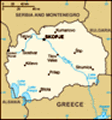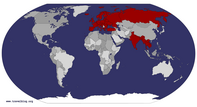Advertisement
Woolly says – with the rain sheeting down it was a relief to see our coach arrive, finding our seats at least allowed us to drip quietly for the duration of the trip! As Jo and I admired the incredibly lush green hillocks and comment on the neat little fields that had two metre widths of crops instead of the British idea of every inch with the same crop, Zoe took up her usual prone position with headphones in and eyes closed. The miles passed and as dusk settled around us we drove up to the border post and the opportunity to cross into yet another country if only for a couple of days. Having based ourselves in Durres for a couple of weeks we were determined to make the most of visiting the neighbouring countries without the hassle of carrying everything we have with us.....less shoulder ache! Woolly says - Although Macedonia is a young state which became independent in 1991 from Yugoslavia......strangely for Jo and I, Zoe has never heard of this former country as it ceased to exist before her birth! Its roots run deep in history, the name "Macedonia" is in fact the oldest surviving name of a country in the continent of Europe. Archaeological evidence shows that old European civilization flourished in Macedonia between 7000 and 3500 BC. The origins of the Macedonians are in the ancient Brygian substratum which occupied the whole of Macedonian territory and in Indo-European superstratum (you can look that up!), which settled here at the end of the 2nd millennium. It has a vast history including my favourites the Romans! During the Kosovo War in 1999, an estimated 360,000 ethnic Albanian refugees from Kosovo took refuge in the country, which bought it firmly into the media eye. Although they departed shortly after the war, Albanian nationalists on both sides of the border took up arms soon after in pursuit of independence for the Albanian-populated areas of Macedonia. It is also known for it’s very fetching flag! Arriving at the border Jo obliging handed over our passports along with the other travellers. Minutes passed, then more minutes, then a few more, having exhausted my snack supplies I suggested to Jo that we just collect our identification and walk over but apparently we couldn’t do that.
Over an hour passed and just as I was thinking of suggesting to my small but annoying friend that he could walk over the border and we would meet him there a border guard climbed onto the bus and shouted out some names. A further twenty minutes on and the two men returned, collected their belongings and left!
Woolly says – the coach moved forward through ‘no mans land’ and stopped at the Macedonian border, home of the nut! Again our passports were collected and again we waited and waited and waited, I tried to engage Jo in conversation about Macedonia nuts but she laughed....again! It doesn’t seem to matter how many times I explain that the Macadamia nut is nothing whatsoever to do with Macedonia he will not have it! Woolly says – It’s where the nuts come from, I’m sure of it! Before the argument could become more heated and after a further hour and a half we rumbled on, alighting at a town that sounds like strudel, I glanced around to see if they had any pie for sale but other than taxi drivers they didn’t appear to have anything much. A short car journey and we were finally able to put our heads down for the night....lots to do in the morning!
The rains seemed to have subdued somewhat but armed with rain coats we left our hostel and set off to find the delights that Ohrid had to offer. Woolly says - Ohrid is probably best known for it’s lake and beautiful views and as we reached the small harbour I could only agree with that. It is also notable for once having had 365 churches, one for each day of the year, and has been referred to as a "Jerusalem of the Balkans”, in 1979 and in 1980, Ohrid and Lake Ohrid were accepted as Cultural and Natural World Heritage Sites by UNESCO. My first idea was to take in the views from the lake and with no arguments from the women I trotted off to discuss payment with a rather tall man wearing a captains hat. Captain Bobi was happy to take us out and as we puttered into the clear lake the only issue seemed to be the black looming clouds that make every picture look as though we were in the dark! As we crossed the bay Bobi told us snippets about the area and the purity of the lake who’s water is drinkable, I sat and admired the church of St John of Kaneo a combination of Byzantine and Armenian architectural styles. Built in honour of St. John the Theologian, St. Kaneo is known as an inspiring place for spiritual contemplation, consecrated at the end of the 13th century it was to be our first stop of, having waved our Captain goodbye we climbed the steps upwards and admired the architecture in closer detail.
As Woolly admired the brickwork I went to see if it would be possible to go inside and having located a nice young man we entered the small but beautifully formed building to admire the fresco’s from the middle ages that covered the walls and high doomed ceiling. Woolly says - like many of our recent visits we were unable to take pictures but as I counted the 27 seats and the girls gazed happily at the walls I can say that it was divine. Having taken our fill and thanked the young gentleman we followed the pathway through the lovely pine woods towards the rather stunning building of the church of St Clement, the exterior was incredible as were the views across the lake, Saint Panteleimon (as it is really known) is actually a monastery attributed to Clement of Ohrid, a disciple of Saint Cyril and Saint Methodius. Archaeologists have come to believe that the monastery was built when Saint Clement arrived in Ohrid, at the request of Boris I of Bulgaria who restored it from an old church. Sources say that Saint Clement was not satisfied with the size of the church and therefore built a new one over it and assigned Saint Panteleimon as its patron saint. Saint Clement used his newly created monastery as a liturgical building and a place for teaching his disciples his variation of the Glagolitic alphabet, known as the Cyrillic script. Trotting inside I couldn’t wait to see what delights it held..... well it was white, very very white and other than the coffin of Clement there wasn’t a lot to see!
The outside definitely provided more for the eye but to cheer up my furry companion I pointed in the direction of the basilica built in 893 which showed off some most impressive floor mosaics.
Woolly says – they were rather lovely and having admired them and the lack of information I thought it was time to take in the fortress that was looming above our heads. In Byzantine times, Ohrid had been a large important city and cultural centre. For a short time in the early 11th century it was also the capital of a Slavic empire ruled by Tzar Samuil, it was once one of the most impregnable strongholds in the Balkans, with walls 3 km (1.8 m) long and 16 m (52 ft) high. Having taken the short hike to the top and leaving Jo to dish out some more notes...you have to love a currency that seems to deal in notes only.....I attempted to climb up the steep steps to inspect the remaining towers! Even I found the stone stairs difficult so having picked the mammoth up we took to the blustery fortifications. Woolly says – the view was impressive and but other than the walls there didn’t seem much to see, as we climbed back down and then back up another tier of steps of equal height we found ourselves able to peer over the railing to watch excavation of the site taking place, reaching the last turret that we were able to access I was overjoyed to see much of what had already been uncovered beneath us, lacking in information we could only stand and admire but it might well be worth coming back in fifty years or so to see how progress was going!
A brief snack break and we followed the quaint cobbled roads past church after church before finding the entrance to the amphitheatre. Woolly says - built in 200 BC it is the only Hellenistic-type theatre in the country and although only the lower seating areas remain it must have made a wonderful place to watch gladiators and lions whilst looking across the beautiful lake. Down the cobbled paths went and as church after church presented itself we made a sudden discovery of what appeared to be a Roman road with some still erect columns and mosaic footpaths, just as I thought there could be nothing else left we turned a corner to be greeted by the wonderful sight of the Church of St. Sophia which is the biggest church in the area, built during the First Bulgarian Empire, after the official conversion to Christianity between 852 – 889, it was converted into a mosque during the rule of the Ottoman Empire before being retuned to the catholic church. We stood admiring the delightful place and having paid out another note Jo led us inside to look at the frescos, now old and barely visible they must have been specular when first done, again cameras weren’t allowed but in the interests of perseveration it’s understandable. Padding my way through the old town our day seemed to be complete when we came upon some university students celebrating a cultural day and telling the story of how Ghana had become a country in it’s own right, so different to what we had seen during our walk but wonderfully entertaining all the same.
With tired legs and paws and growling tummies we sat over a lovely lunch discussing our brief time in the wonderful town of Ohrid, everyone was in agreement that it was a beautiful place to visit and if the sun had presented itself it would have been amazing.
Woolly says – the countries flag is worth a visit let alone anything else, now where can I get my Macedonia nuts from?
Advertisement
Tot: 0.127s; Tpl: 0.012s; cc: 15; qc: 32; dbt: 0.0629s; 1; m:domysql w:travelblog (10.17.0.13); sld: 1;
; mem: 1.2mb



























taracloud
Tara Cloud
What history!
How lovely that there are still 9c churches with incredible mosaic floors and beautiful brickwork--hard to find these ancient treasures in Western Europe! Quite thoughtful of the Muslims to just convert them to mosques rather than destroying them. The views, the woods--it all looks lovely, and so brilliant to base yourself in one place and go for shorter jaunts!